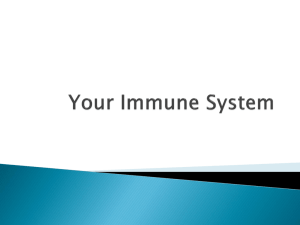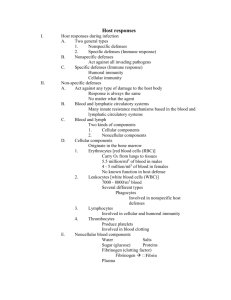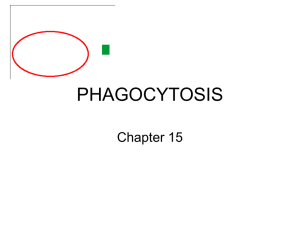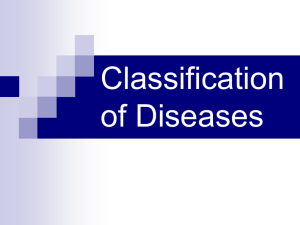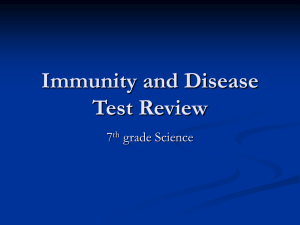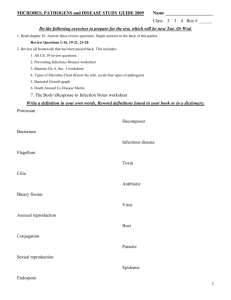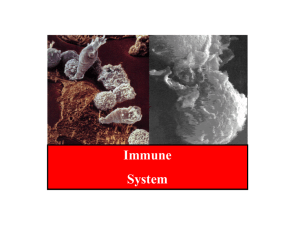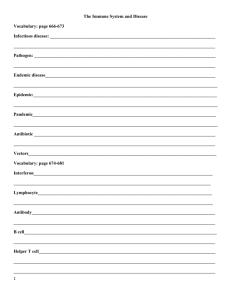(and all other animals) have a very powerful defence mechanism
advertisement
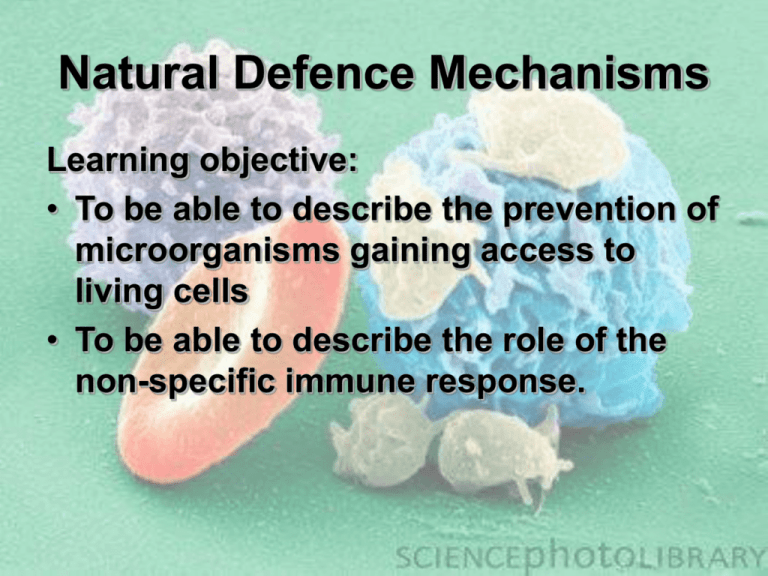
Natural Defence Mechanisms Learning objective: • To be able to describe the prevention of microorganisms gaining access to living cells • To be able to describe the role of the non-specific immune response. • We are surrounded by microbes in the air, on the ground and all other surfaces, and in our food and water. • The only reason we are still alive is because humans (and all other animals) have a very powerful defence mechanism: The Immune System. Possible sites of entry into the body • Nose • Ears • Eyes • Mouth • Genitals • Cuts in the skin First line of defence • The skin • Sweat and tears • The digestive tract • The respiratory tract The skin • The outer layer, the epidermis, is 20-30 cells thick (about as thick as a sheet of paper) and its cells are toughened by the protein keratin, forming an impenetrable barrier to invading microbes • The next layer, the dermis, is 20-40 times thicker and provides the main structure for the skin as well as all the receptor cells, blood vessels and hairs. • Cells are constantly being lost from the surface of the skin (to form dust) and are replaced by new cells from further down. Sweat and tears • These are secreted by glands in the skin and contain lysozyme enzymes, which destroy (lyse) bacteria growing on the surface of the skin by digesting their peptidoglycan cell walls. The digestive tract • This is a potential entry route for pathogens, but it is protected by concentrated Hydrochloric acid in the stomach, which denatures microbial enzymes and cell surface proteins, • In the stomach there are also protease enzymes. • Saliva also contains lysozymes. The respiratory tract • This is protected by sticky mucus secreted by glands in the bronchi and bronchioles, which traps microbes and other particles in inhaled air before they can reach the delicate alveoli. • The mucus contains lysozymes, and there are cilia constantly sweeping the mucus upwards to the throat, where it is swallowed so that the microbes are killed by the stomach acid. Say hello to the friendly bacteria…. • The human body is home to billions of bacterial cells • These may be known as the natural microbiota, the normal flora, the commensal flora (because they have a non-harmful or commensal relationship with their host) or even the "friendly bacteria". • There are more bacteria cells in a human than there are human cells. • These commensal bacteria colonise the skin, mouth, lower digestive tract, respiratory tract and vagina, and they help prevent infection by outcompeting pathogenic microbes for food and space. The core’s been breached Captain • So what happens if this first line of defence is broken? • Enter….. The parts of the immune system are spread all over the body. They include: Lymph nodes in neck Lymph nodes in armpits thymus spleen Lymph nodes in groin • The lymph and blood vessels transport pathogens and leukocytes all over the body. • The lymph nodes contain millions of phagocyte and lymphocyte cells, which identify and remove pathogens from lymph. • The spleen also contains millions of phagocyte and lymphocyte cells, which identify and remove pathogens from blood. • Blood stem cells are differentiated into T-lymphocytes in the thymus. Once in the thymus they are activated. These activated or COMPETENT T-lymphocytes pass to the lymph nodes and spleen Leukocytes • Leukocytes are white blood cells that defend the body from the invasion of microbes • Leukocytes are derived from stem cells, which are produced in huge numbers in the bone marrow • These stem cells differentiate to form all types of blood cell, from platelets, red blood cells to the dozens of different kinds of leukocytes. • Leukocytes fall into four categories. White blood cells (leukocytes) Phagocytes Granulocytes For inflammation T Lymphocytes For cell mediated immunity B Lymphocytes For antibody mediated immunity For phagocytosis Macrophages Neutrophils Monocytes Mast cells Eosinophils Basophils Helper T cells Killer T cells Memory T cells B cells Plasma B cells Memory B cells Non specific immune system Specific immune system Non specific immune system • The phagocytes and the granulocytes form the non-specific immune system, which kills pathogens quickly and indiscriminately. • Although effective, it does not lead to immunity to a disease as it does not "learn from experience". • Granulocytes initiate the inflammatory response • Phagocytes kill bacteria by phagocytosis. Inflammatory response • The inflammatory response is a localised response to injury or infection. • The granulocyte cells and the affected cells release chemicals, including histamines and prostaglandins. • These chemicals cause: – vaso-dilation to increase the flow of blood to the area (so the area turns red); – capillary leakage so that phagocytes and granulocytes can enter the local tissue fluid (so the area swells); – sensory neurone impulses (so the area is tender or painful); – blood clotting to seal a wound (so a scab is formed). – The dead pathogens and phagocytes, together with excess tissue fluid, are release as pus. – The chemicals also help to stimulate the specific immune response Feeling hot? – Pyrexia is caused by pyrogen chemicals, which include some of the inflammation chemicals as well as bacterial endotoxins. – These stimulate the hypothalamus of the brain to increase the body's temperature from 37°C up to 39°C. This helps the immune system and inhibits growth of some pathogenic bacteria. Phagocytes • Phagocytes are large, irregularly-shaped leukocyte cells that remove bacteria, viruses, cellular debris and dust particles. • Phagocytosis is carried out by both neutrophils and macrophages, the only difference is the location of their action. • Neutrophils circulate in the blood, while macrophages are found in lymph, tissue fluid, lungs and other spaces, where they kill microbes before they enter the blood. Non specific immune response • Cells under attack produce histamine. • Pathogens release chemicals. • These both attract phagocytes (chemotaxis). • Pathogens may be covered in marker antibodies (from B lymphocytes). This stimulates phagocytes to attack as they have receptor proteins which recognise antibody molecules and attach to them. Phagocytosis • The phagocytes are constantly changing shape, and they flow over microbes, surrounding and ingesting them through the process of phagocytosis to form a phagosome. • The phagosome then fuses with lysosomes small vesicle containing lysozymes, which are released into the phagosome, killing and digesting the microbe. The bacteria will be attracted to the membrane of the neutrophil Phagocytosis. The neutrophil will engulf the bacteria. Once in the neutrophil, lysosomes (vesicles containing digestive enzymes) will form and make their way towards the phagosome containing the bacteria. The lysosomes will fuse with the phagosome. Now the bacteria will be killed and digested by enzymes. Macrophages • Macrophages make proteins that act in two ways: • By making pores in their cell membranes and can also inhibit viral reproduction inside cells. • Or by the proteins sticking to the outside of the bacteria to make them more appealing for the phagocytes to eat. Complement System. • This comprises more than 20 different proteins, which kill microbes by making pores in their cell membranes and can also inhibit viral reproduction inside cells. • They are also involved in activating other parts of the immune system. Question • Macrophages are a type of white blood cell involved in protecting against disease. One of their functions is to release substances called pyrogens which cause a fever to develop. (a) Give two ways in which macrophages protect against disease, other than by producing pyrogens. (2 marks) 1. phagocytosis / engulf and digest (allow ingest, destroy, inactivate); 2. antigen presenting; » 2 marks
